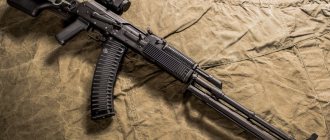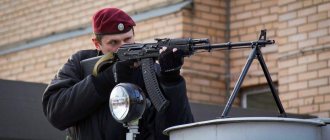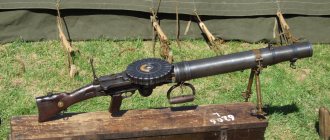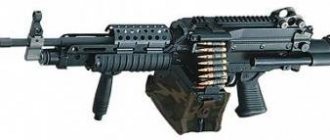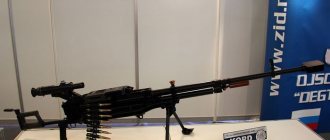| This article requires additional links for verification . |
Type of light machine gun
| Vz. 26 | |
| vz. 26 in the Museum of the Great Patriotic War, Smolensk | |
| Type | Light machine gun |
| Place of origin | Czechoslovakia |
| Service history | |
| In service | 1926–present |
| Used | See Users |
| Wars | Second Sino-Japanese War Chaco War Spanish Civil War Second Italo-Ethiopian War Dersim Rebellion World War II Ecuadorian-Peruvian War [1] Chinese Civil War Korean War Indochina War Vietnam War Laotian Civil War Biafran War Aceh Insurgency [ 2] South African border War Soviet-Afghan war Yugoslav wars [3] |
| Production history | |
| Designer | Vaclav Golek |
| Designed by | 1924 |
| Manufacturer | Zbrojovka Brno, Military Technical Institute Kragujevac [4] |
| Produced | 1924–1953 |
| Options | View options |
| Characteristics | |
| Weight | 9.65 kg (21.27 lb) [5] |
| Length | 1161 mm (45.7 in) [5] |
| Barrel length | 672 mm (26.5 in) [5] |
| Cartridge | 7.92×57mm Mauser |
| Action | Gas butterfly valve |
| Rate of fire | 500 rounds/min [5] |
| starting speed | 764 m/s (2,507 ft/s) [5] |
| Effective firing range | 1000 m (1100 yd) |
| Feeding system | Detachable box magazine for 20 or 30 rounds [5] |
| Attractions | Front blade, rear sight |
Model ZB vz. 26
was a Czechoslovak light machine gun developed in the 1920s that entered service with several countries.
It was used extensively during World War II and spawned the related ZB vz. 27, vz. 30 and vz. 33. ZB vz. 26 influenced many other light machine gun designs, including the British Bren light machine gun and the Japanese Type 96 light machine gun. The ZB-26 is renowned for its reliability, simplicity of components, quick-change barrel, and ease of manufacture. This light machine gun in the Czechoslovak army was designated LK vz.
26 ("LK" means
lehký kulomet
, light machine gun; "vz."
means vzor
,
model
in Czech). ZB vz. 26 is an incorrect nomenclature because “ZB-26” is the factory designation (Československá zbrojovka v Brně), and “vzor 26” or “vz. 26" - army designation.
Development[edit]
Around 1921, the military of the young Czechoslovak state began searching for its own light machine gun. Early studies included foreign designs such as the Berthier, Browning M1918, Darne machine gun, Hotchkiss M1914 machine gun, Madsen, St. Etienne Mle 1907, as well as several domestic designs. Of these, the most important was the Praha II, a belt-fed light weapon built at Česka Zbrojovka (CZ) Praha (Czech arms factory in Prague).
Development of the ZB-26 began in 1923 after the construction of the Czechoslovak arms factory in Brno. Since CZ-Praha was a relatively small plant with limited production capabilities, it was decided to transfer the production of the new automatic weapons to the more advanced Zbrojovka Brno, or ZB for short. This transfer led to a long series of lawsuits over royalties between the owners of the design (Czech Republic-Prague) and the manufacturer (ZB). The Czechoslovak Army commissioned designer Vaclav Holek to produce a new light machine gun. He was assisted by his brother Emmanuel, as well as two Austrian and Polish engineers named Marek and Podrabski respectively. [6] Holek quickly began work on the Praha II prototype, and within a year the quartet had created an automatic light machine gun that would later become known as the ZB.
The Holek brothers soon abandoned the belt-fed gun in favor of a top-feed box magazine, resulting in the weapon of choice known as the Praha I-23. Despite past problems with the law, production of the new weapon began at the ZB factory towards the end of 1926, and by 1928 it became the standard light machine gun in the Czechoslovak Army.
Design[edit]
The ZB-26 is an air-cooled gas selective fire machine gun. It has a finned, quick-release barrel and fires from an open bolt. Its action is driven by a long-stroke gas piston located under the barrel. The gas block is installed at the muzzle end of the barrel and at the same time serves as the base of the front sight. The engine is secured by folding the rear of the bolt (bolt) upward into a locking recess in the receiver. The recoil spring is located in the butt of the weapon and is connected to the bolt carrier/gas piston via a long rod; In addition, around the return spring at the junction of the receiver and the butt there is a short spring shock absorber, which softens the shock of the bolt group at the end of its rearward stroke.
Its charging handle is located on the right side of the receiver and does not reciprocate when fired. Ammunition is fed from a top-mounted sheet steel box magazine, holding only 20 rounds in a double-stack configuration. The magazine body is equipped with a dustproof cover that slides forward. Spent cartridges are thrown down. The ejection port is usually covered by its own dust cap, which opens automatically when the trigger is pulled. The trigger allows both single shots and full-auto fire, selectable via the safety/fire selector lever located on the left side of the pistol grip. The bolt is fired from an open bolt and a spring-loaded firing pin, activated by a protrusion on the bolt carrier when the bolt is fully charged and locked. Due to the overhead magazine, the sight line is offset to the left and the front sight is mounted on a base that extends up and to the left of the gas block.
The rear sight is mounted on the left side of the receiver and has a range adjustment mechanism controlled by a knurled rotary knob. The standard furniture consists of a one-piece folding bipod, which is attached to the gas cylinder tube, and a wooden stock with a spring-loaded butt plate and folding shoulder plate. Although intended as a light machine gun, the ZB-26 was also offered with a continuous fire tripod and with a sufficient supply of full magazines and spare barrels, it could serve (to some extent) as a medium machine gun. . The same tripod could also be adapted for the anti-aircraft role.
Design description[edit]
Developed on the basis of the ZB vz machine gun. 26, differed in the design of the eccentric that drove the bolt, and the system for actuating the striker. Equipped with a 7-step regulator, with which it was possible to regulate the amount and intensity of the flow of powder gases into the cylinder. It was assembled from high-quality materials, was stronger and more reliable than its predecessors, and had higher accuracy. Power is supplied by Mauser rifle cartridges. ZB vz. 26 is an automatic weapon with a long stroke gas piston. The gas piston, with the help of which powder gases removed from the barrel bore reload the weapon, is located under the barrel. The machine gun has an air-cooled quick-change barrel. The barrel is locked by tilting the bolt. The box magazine holds 20 rounds, is inserted from above, and the spent cartridge is thrown down. The barrel change handle was also used as a carrying handle.
Deployment and maintenance[edit]
The ZB-26 served with the Czechoslovakian infantry from 1928, and was also the primary or secondary armament on many later models of Škoda armored personnel carriers. 45,132 were purchased by Czechoslovakia during the interwar period. [7] It is believed that between 1926 and 1939, the ZB factory produced over 120,000 ZB-26 guns in various calibers (the most popular being the original 7.92×57mm Mauser). It was exported to twenty-four countries in Europe, South America and Asia, both in its original form and as a slightly improved version of the ZB-30. Large shipments of ZB light machine guns went to Bolivia, Bulgaria, China, Romania, Turkey and Yugoslavia. Lithuania and Yugoslavia were the first users to adopt this gun before the Czechoslovak Army. [7]Exports continued until 1939, when Nazi Germany, under the leadership of Adolf Hitler, captured Czechoslovakia. More were produced for export than for the Czechoslovak army [8]. 7,136 ZB-26s were produced in Czechoslovakia after the war, from 1945 to 1953.[7]
Chinese soldiers were the main users of the ZB-26 during World War II.
The Wehrmacht soon adopted the ZB-26 after the occupation of Czechoslovakia, renamed it MG 26 (t)
;
[9] It was used in the same role as the MG 34, as a light machine gun. During the early stages of World War II, the ZB-26 7.92mm Mauser was used in large numbers by elements of the German Waffen-SS, who at first did not have full access to the Wehrmacht's standard supply channels. In its most famous incarnation, the ZB-26 was modified by ZB and British technicians and entered service as the famous Bren gun. [10] Many other countries imported or licensed the design, including China and Yugoslavia. Chinese Nationalist forces used the ZB-26 chambered in 7.92×57mm Mauser in fighting the forces of Communist China and later the Japanese Empire. Likewise, the Chinese Red Army (as well as any other captured weapons) turned the Nationalists' ZB-26 machine guns against them and the Japanese. According to Brno, from 1927 to 1939, 30,249 ZB-26s were exported to China. [7] It was used by various Chinese pro-Japanese forces, such as the Collaborationist Chinese Army [11] or the Inner Mongol Army. [12] During this time, due to high demand, Chinese small arms factories - both state-owned and controlled by various warlords - produced the ZB-26. During the Korean War, Chinese Communist forces used the ZB-26 against UN troops, and the PVA ZB gunners earned a well-deserved reputation as long-range marksmen. [ citation needed
] During the First Indochina War with French and later South Vietnamese forces, the ZB-26 found itself in the hands of both North Vietnamese armies and Viet Minh guerrillas. [13]
Options [edit]
Czechoslovak soldiers with ZB vz. 26 and vz. 24.
- ZB vz.
24 : predecessor of the weapon. [7] - ZB vz.
27 : later version proposed to Portugal and the United Kingdom. [14] - ZB vz.
30 and ZB 30J: later versions. - ZGB 30
: final modifications vz. 30 for British tests. - ZGB 33
: in its final form was almost identical to the English Bren light machine gun. - ZB 39
: Commercial variant, similar to the Bren, with different cartridges and different sights, among other minor changes. [15] - ZB vz. 52: post-war version of ZB vz. 26.
- The Japanese Type 97 heavy tank machine gun was a licensed copy of the ZB-26 and was intended for use in Japanese tanks. It was not generally issued as a light infantry machine gun. Except for the fact that the cocking handle was moved from the right side of the receiver to the left, it is essentially a copy of the current Czech weapon.
- The Spanish Fusil ametrallador Oviedo was a post-war clone of the ZB vz.26/30.
More designations appear depending on the adopting army, although the initials ZB 26 are usually retained on the pistol in some form.
Accessories[edit]
Together with the ZB-26 machine gun, the following were adopted into service with the pre-war army of Czechoslovakia:
- device for accelerating loading of magazines;
- a machine for firing at air targets;
- machine gunner's assistant bag - for carrying an oil can, accessories for cleaning weapons, spare parts and accessories for the machine gun;
- pouches for carrying magazines (two pouches for two magazines of 20 rounds each) - thus, the portable ammunition of the machine gun crew of the Czechoslovak army was 160 pieces. cartridges (80 pcs. for the machine gunner and 80 pcs. for the assistant machine gunner);
- metal box for transporting magazines (for 10 magazines);
In the Romanian army, a metal box for transporting magazines (for 12 magazines) was adopted for the machine gun.
Users[edit]
Chinese National Revolutionary Army soldiers fire a ZB vz. 26.
Yugoslav Chetnik fighter with M37.
- Afghanistan [16] [17]
- Bolivia [18]
- Brazil: 1,080 7 mm Mausers received in 1930 [19] for the Polícia Militar de Minas Gerais (Military Police of the State of Minas Gerais) [ citation needed
] - Bulgaria: 100 delivered from an order of 3,000 ZB-39 chambered in 8×56mmR [15].
- Biafra [20]
- Chile: 11 inches 7 mm received in 1928[19]
- People's Republic of China [21] [22]
- Republic of China: 30,249 received between 1927 and 1939. [19] Manufactured under license. [23] Clones made at the Taku Navy Yard in 1927, later produced at the Gongxiang Arsenal, 21st and 51st Arsenals. [24]
- Independent State of Croatia [ link needed
] - Czechoslovakia: Adopted into service with the Czechoslovak Army as the ZB LK VZ 26
. [24] [25] - Ecuador: [26] 200 delivered 1930-1932. [19]
- Egypt: 1,060 7.7 mm ZGB-33 purchased 1937-1939. [19]
- Ethiopia: Used against Italians [18]
- Nazi Germany
- Indonesia: Free Aceh Movement [2]
- Kingdom of Iraq: 850 7.7 mm ZGB-33 received in 1936-1937. [19]
- Imperial State of Iran: ZB vz. 30 produced under license [27] 6000 ZB-26 received in 1934 [19]
- Empire of Japan: used captured Chinese guns [28] 2,200 others were received in 1938-1939. [19]
- North Korea [29]
- Latvia: 600 7.7 mm ZGB-33 ordered in 1940.[19]
- Lithuania [7] 3,138 vz machine guns. 26 between 1928 and 1937 [19] (7.92 mm kulkosvaidis Brno
26 m.) - Manchukuo [30]
- Namibia: Used by the Namibian People's Liberation Army. [31]
- Paraguay: Captured by the Bolivian Army during the Chaco War, some are still used for training. [ citation needed
] - Peru [1]
- Romania: ZB vz. 30 produced under license [27]
- Siam: purchased early 1930s [19]
- Slovak Republic [32]
- Spain [5] [33]
- Sweden: Used as Kulsprutegevär m/39 [34]
- Türkiye [18] [35]
- UK: 85 7.7 mm ZB-33 purchased from 1935 to 1938 [19]
- North Vietnam [36] [37]
- Yugoslavia: [7] [38] 1,500 delivered [19]
- Kingdom of Hungary: After the annexation of Czechoslovakia, Hungary received many Czech weapons and uniforms, including the ZB vz 26.
Machine gun ZB vz. 26. How did the Czechoslovak light machine gun become the “inconspicuous winner of many wars”?
From Russian Wikipedia about the Bren machine gun: “The new machine gun (which replaced the Lewis machine gun) took its name from the first two letters of the names of the cities of Brno and Enfield, in which production was launched.”
Well, ZB vz. 26 is the “father” of not only the British Bren light machine gun. And also the Spanish FAO, the Yugoslav M.37... This reliable and unpretentious machine gun, like the mod. 1926, and a slightly modified modification of the copy of ZB vz. 30 arr. 1930, was officially in service in 24 countries, even if you don’t count the Bren machine gun, an exact copy of the ZB vz. 26. chambered for the British cartridge .303 British, which was in service with the armies of the entire British Commonwealth until the 80s of the 20th century (production years 1935−1971). In Czechoslovakia itself, the modernized ZB vz. 26 under the index ZB vz. 52/57 was produced under the M43 intermediate cartridge for the Kalashnikov assault rifle and served until the early 60s of the twentieth century, until it was replaced by a more powerful modification - ZB vz. 59, chambered for the 7.62x54 R rifle cartridge, which was the standard machine gun of the Czechoslovak Army until the collapse of the Warsaw Pact.
What made this “machine gun from Brno” stand out among its many “classmates”?
Lightness, reliability, convenience and, as the Chinese, who greatly respected this machine gun, said, “a special fighting spirit.” It was made from high-quality materials, with minimal tolerances, as a result of which it was more reliable, more accurate and lighter than all its “classmates” of that time.
In 1921, Czechoslovakia, which inherited a fairly developed arms industry from the Austro-Hungarian Empire, began searching for a light machine gun design that would replace many outdated foreign designs. Among the many foreign models put up for competition in 1923, the military singled out the Praha II light machine gun, created at the Česka Zbrojovka Praha plant by the talented gunsmith Vaclav Holek, as the most promising. However, the belt-fed machine gun was, according to the military, too heavy and took too long to reload. The following year, Holek replaced the belt with a quick-release magazine. It was this option that was chosen by representatives of the Czechoslovak army as a new infantry light machine gun.
Light machine gun ZB vz. 26 is an automatic weapon with a long stroke of gas automatics. The gas piston, with the help of which powder gases removed from the barrel bore reload the weapon, is located under the barrel. The quick-change barrel is air-cooled. The barrel is locked by tilting the bolt. A box magazine with 20 rounds is inserted from above, the spent cartridge case is thrown down. The barrel change handle was also used as a carrying handle.
The machine gun allows single and automatic fire; the fire mode selector is located with the fire control handle on the left. The machine gun is equipped with a folding bipod attached to the bottom. The butt plate is spring-loaded to reduce recoil. In addition, a special tripod machine was developed for this machine gun, which made it possible to fire at both ground and air targets. Sector sight, diopter. To speed up the loading of stores, a special spring lever was used, called a “loading accelerator”.
Tactical and technical characteristics of the ZB vz.26 light machine gun:
Caliber: 7.92 mm Ammunition: 7.92×57 mm Mauser Length: 1161 mm Weight: 9.65 kg Muzzle velocity: over 750 m/s Rate of fire: 500−650 rds/min
A gas regulator added in 1930 increased the weapon's weight to 10.04 kg.
After testing the machine gun “in action,” it began to be installed on armored vehicles and light tanks.
Practical Czechs immediately began offering the machine gun for export. Both manufactured in the Czech Republic and licensed production. China, Yugoslavia, Spain, Britain, British Commonwealth countries... Civil War in China, Civil War in Spain. The machine gun showed its best side.
After the capture of China, ZB vz. 26 of both Chinese and Czech production in quantities of more than 100,000 were used in the Imperial Japanese Army.
The Second World War further contributed to the spread of Czech light machine guns throughout the world. They were used both by Nazi Germany, which received all Czech weapons, and by countries that opposed it, including the Soviet Union, which received these machine guns when they annexed the Baltic republics. And even the German rifle cartridge for which these machine guns were made came in very handy, because these weapons were supplied to partisan formations in the territory occupied by the Germans.
For production in wartime, the machine gun was “delightfully low-tech,” but what to do, there was nothing to replace a reliable and proven “machine” in the British Army. “For the production of the receiver, about 550 measurements and 270 operations were necessary, and a part weighing up to 2 kilograms was obtained from a workpiece weighing 10 kilograms - for wartime, such metal losses were very sensitive.” However, simplifying the production of the receiver resulted in a sharp loss of reliability. Therefore, when producing licensed samples in England and Canada, they saved on other things: on the length of the barrel, they simplified the butt, instead of telescopic bipods they simply made folding ones...
After World War II, the machine gun also did not remain “out of work.” First of all, the Korean War, in which Chinese and English clones of ZB vz.26. After this war, not a single monument to the heroes of that war in North Korea is complete without this machine gun.
“There is a legend that after the war, the great leader and teacher Kim Il Sung toured military units. In the arsenal of one of the units, he noticed a ZB vz. 26, picked it up and said:
- This is a good machine gun. He helped us a lot at the front.
The accompanying generals nodded approvingly:
- Yes Yes. Good, helped a lot."
And they began to make monuments to heroes with a machine gun, which the “father of the people” liked so much.
Next is Vietnam... And further, further, further. Everywhere this machine gun was spoken of as a standard of reliability and accuracy. But times are changing. The weapons have changed, new ammunition has replaced the old ones. The last ZB vz.26 machine guns and their numerous clones “left the scene” already in the 80s of the last century. And collectors still pay a lot of money for them just to “touch history.”
Tags: history of weapons, shooting, weapons, technology, inventions, Czechoslovakia
Links[edit]
- ^ ab Jowett, Philip (28 June 2022). The Latin American Wars 1900–1941: "Banana Wars", Border Wars and Revolutions. Action 519. Osprey Publishing. paragraph 39. ISBN 9781472826282.
- ^ ab Davis, Matt (27 September 2006) [1970]. Indonesia's War for Aceh: The Last Stand on the Porch of Mecca (e-book, ed.). London: Routledge. paragraph 32. DOI: 10.4324 / 9780203968802. ISBN 9781134193318.
- Defense of Bosnia. Studio "FLASH" Sarajevo. April 1999. The event occurs at 45:53. Retrieved May 22, 2015. [ need better source
] - https://www.zastava-arms.rs/sr/imagetext/1919-1941
- ^ abcdefg "Military shooters Lehky Kulomet ZB vz.26 and vz.30." Encyclopédie des armes: Les forces armées du monde
(in French).
II
. Atlas. 1984. p. 262. - Smith, Joseph E. (1969). Small Arms of the World (11th ed.). Harrisburg, PA: Stackpole Company. paragraph 125.
- ^ abcdefg "Lehký kulomet ZB 26" [ZB 26 light machine gun]. vhu.cz
(in Czech). Vojenský Historický ústav Prague [cs]. - Grant, Neil (2013). Bren pistol. Weapon 22. Osprey Publishing. paragraph 10. ISBN 978-1782000822.
- ↑
Encyclopedia of World War II Weapons by Chris Bishop, page 237. - Skřivan Ales (2010). "On the nature and role of arms production in interwar Czechoslovakia" (PDF). Journal of Slavic Military Studies
.
23
(4): 630–640. DOI: 10.1080/13518046.2010.525488. S2CID 154648623. Archived from the original (PDF) on March 3, 2022. - Jowett 2004, pp. 46,71.
- Jowett 2004, pp. 51,56.
- Windrow, Martin (20 September 2022). French Foreign Legionnaire against the Viet Minh Rebels: North Vietnam 1948–52
. Combat 36. Osprey Publishing. pp. 24–25. ISBN 9781472828910. - “Čs. Lehký kulomet ZB vz. 27" [Czech light machine gun ZB vz. 27]. vhu.cz
(in Czech). Vojenský Historický ústav Prague [cs]. - ^ a b "ZB 39". iwm.org.uk.
_ Imperial War Museum. - Bhatia, Michael Vinay; Sedra, Mark (May 2008). Small Arms Review (ed.). Afghanistan, Arms and Conflict: Armed Groups, Disarmament and Security in Post-War Society. Routledge. paragraph 65. ISBN 978-0-415-45308-0.
- "World War II Equipment in Afghan Use: Part I - Firearms". wwiiafterwwii.wordpress.com
. June 1, 2015. Retrieved April 10, 2022. - ^ abc Grant 2013, page 65.
- ^ abcdefghijklm Fencl, Jiří (1991). "Nejprodávanější československá zbraň" (in Czech). Militaria, Elka Press. Retrieved March 12, 2022.
- Jowett, Philip (2016). Modern African Wars (5): The Nigerian-Biafran War 1967-70
. Oxford: Osprey Publishing Press. paragraph 23. ISBN 978-1472816092. - Jowett, Philip (13 July 2005). Chinese Army 1937-49: World War II and Civil War
. Osprey Publishing. paragraph 44. ISBN 1-84176-904-5. - https://www.sadefensejournal.com/wp/?p=2406
- Jump up ↑
Smith 1969, pp. 295-296. - ^ ab https://www.chinaww2.com/2014/09/27/favorite-machine-gun/
- ↑
Gun Digest Book of Cz Firearms by Robb Manning, page 22. - "Zarumilla War 1941: Ecuadorian Peruvian War 1941". globalsecurity.org
. Retrieved February 2, 2022. - ^ ab Smith 1969, p. 320.
- Smith 1969, p. 498.
- "North Korean Small Arms (Democratic People's Republic of Korea)". Small Arms Review
. Vol. 16 no. 2. June 2012 - Jowett, Philip S. (2004). Rays of the Rising Sun: The Armed Forces of Japan's Asian Allies 1931-45: Volume 1: China and Manchukuo
. Helion & Company Limited. paragraph 32. - "Their blood waters our freedom". Youtube.com
. January 25, 2022. Retrieved May 19, 2022. - Malmassari, Paul (2016). "The Slovak Republic" . Armored trains
. Seaforth Publishing. item 415. ISBN 9781848322653. Retrieved March 30, 2022. - Smith 1969, p. 547.
- Rihanna
Janson, O. (October 23, 2022).
"Sweden's light machine guns". gotavapen.se
. Archived from the original on December 1, 2022. - Smith 1969, p. 570.
- Chris Bishop (1996). A Vital Guide to Military Implements and Infantry Weapons
. paragraph 203. ISBN 1853105392. - Smith 1969, p. 719.
- Vukšić Velimir (July 2003). Tito's Partisans 1941–45
. Warrior 73. Osprey Publishing. paragraph 25. ISBN 978-1-84176-675-1.



